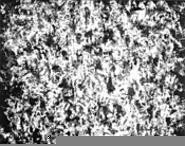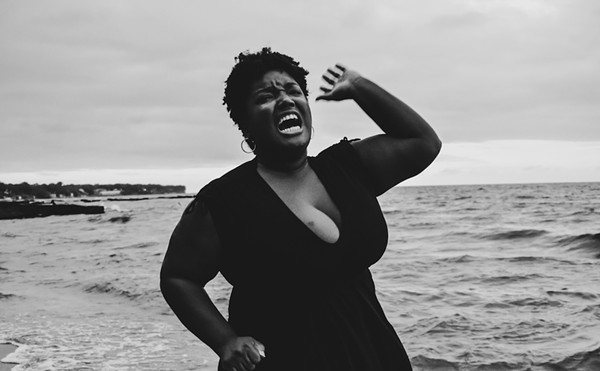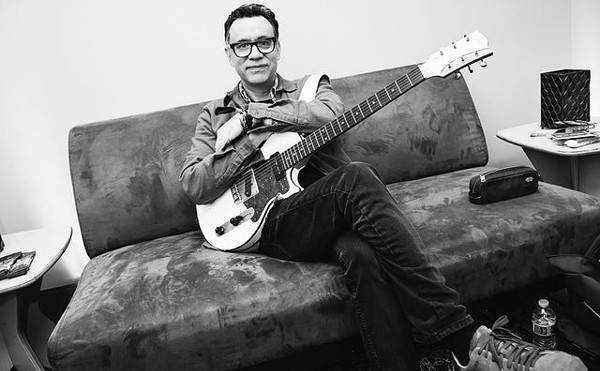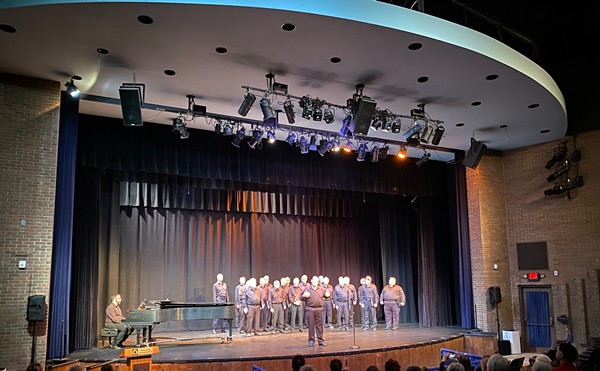The labels clearly state that the six enchanting prints (and one short film) that make up the show are created from photograms -- pictures constructed, sans camera, on photographic paper.
But the black images against stark white paper (or are they white images against black paper?) change as you look at them. First appearing as abstract and random splotches, they morph into recognizable shapes: toy soldiers, lizard skeletons, bugs, tiny ladders. Like the classic visual-perception test in which the picture is either a vase or two heads facing each other, Checefsky's pictures play with the brain. As the viewer's focus of attention shifts, so does the print.
The illusion of depth these works produce also tampers with perception. Things don't look "right" -- at least not to eyes accustomed to watercolors or oils or even photographs. These black-and-white patterns create a lush feeling of three dimensions on what the viewer knows is a flat surface. The combination of abstract pattern and the realism one expects from a photograph also throws off expectations.
Such visual challenges, plus the simple fact that they are lovely, make the photograms on display a pleasure for both eye and brain. Checefsky created them with sheets of light-sensitive paper on which he placed small plastic objects purchased in bulk at a local dollar store. To make "F Troop, 2001," for example, he piled hundreds of four-inch toy soldiers on the paper. Using a flashlight and other light sources, he then illuminated the soldiers from different angles during multiple exposures of varying lengths of time.
Clearly, an artistic sensibility directs these works, though one is not sure whether they "mean anything." In "Bankers Pattern, 2000," the effect is of stained glass, with its repetition of light and shadow. Two untitled prints set side by side appear to be of sweeping, shifting clouds massing over a lake: one fluffy and light, the other dark and promising snow. In "The Other Room, 2001," the plush whites (edged by gray shadows) and deep blacks that crowd the paper suggest the soft curves of landscapes on a Chinese vase.
Checefsky has been working with photograms for years and is recognized internationally as a leading artist in the medium. His technique is one of controlled exploitation of chance, meaning he chooses items to throw down on the paper, but he doesn't arrange them in any particular order. The resulting images are both complex and intriguing.
Although photograms seem new in Checefsky's capable hands, they aren't. The technique became widely known in the mid-1800s, when British scientist William Henry Fox Talbot made "photogenic drawings" with the aid of chemically sensitized paper. Artists in Europe, who embraced this process as part of the wave of modernism that began in the early 1900s, created fanciful names -- Christian Schad's "Schadographs" and Man Ray's "Rayograms" -- but the term used by pioneering Hungarian artists Laszlo and Lucia Moholy-Nagy stuck. Laszlo later immigrated to Chicago, where he helped found what ultimately became the Chicago Institute of Design.
Early artists experimented with using reflective surfaces (such as water) or natural objects (rabbit entrails) to create surreal effects. The goal was to find the new, as Man Ray, an expatriate American living in Paris, wrote to a patron in 1922. He claimed that he had freed himself "from the sticky medium of paint" to work "directly with light itself."
Also part of the show, the four-minute film "Pharmacy" consists of photograms arranged in animated sequence. Checefsky collaborated on it in Budapest last June, in an attempt to re-create a 1930 Polish film that experimented with the use of moving photograms (it vanished during World War II). Using old stills and written descriptions, Checefsky's team put together a succession of pharmaceutical accoutrements appearing and disappearing in rapid order.
But Checefsky's photogram technique is more successful in prints than in film, and the visual effect of "Pharmacy" dims in comparison to the six photograms that make up the show. Their play of shadow and light, depth and surface, control and chance shows that artists can create beauty when they work outside the Brownie camera box.












